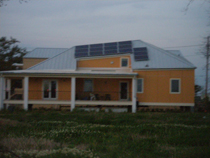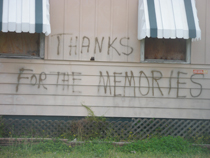There’s just one problem with academia. Sometimes it can be so … academic. In the interest of getting out into the world, I’m writing this post from Nawlins (nee New Orleans), where 16 other Penn planners and I are spending our weeklong spring break doffing our tops for beads and booze doing pro bono city planning work. For most of us, it’s been nothing short of a paradigm shift—and the week ain’t over yet.
There's just one problem with academia. Sometimes it can be so academic.
In the interest of getting out into the world, I'm writing this post from Nawlins (nee New Orleans), where 16 other Penn planners and I are spending our weeklong spring break doffing our tops for beads and booze doing pro bono city planning work. For most of us, it's been nothing short of a paradigm shift-and the week ain't over yet.
We've been working at three separate agencies, doing what we can to make a difference in just a week's time: At City-Works, we're designing proposed improvements for the Urban Main Streets program in Old Algiers and Elysian Fields; at the New Orleans Redevelopment Authority, we're cataloging information about vacant properties and looking at homeownership opportunities; at Neighborhood Housing Services, we're mapping housing conditions in the Central City area. The work is thrilling, but only because it's accompanied by touring the city, trying to learn what happens when a city is destroyed.
Three and a half years later, Katrina's scars still mark the city. Many streets are crackled and broken from the weight of the water that sat on them. Every house and business is defined by whether it's "back" or "gone." Scores of homes still bear the spray-painted markings from when rescue crews searched them-some have left the tattoo as a badge of honor, but most that remain are on houses whose owners have yet to return.
And then there's the Lower Ninth. Many of the wrecked houses have been razed. All that remains is a concrete set of steps leading to what used to be a front door.
Scattered throughout the Lower Ninth are the so-called "Brad Pitt houses"-bankrolled by the actor and designed by Frank Gehry. Back in Philadelphia, we discussed these buildings in urban design class last week: Observing how the multistory futuristic homes, with their big windows and wild angles, contrasted so wildly with the existing vernacular, many derisively dismissed them as out of place and garish. They didn't like the aesthetics; they thought they didn't fit into the neighborhood's character; they pooh-poohed the design-from-without-ness of it all. All valid criticisms.
But there's a problem with judging these houses by looking at a picture of them: You can't tell what's next door.
It's a concrete slab.
Excepting the Brad Pitt houses, entire swaths of the Lower Ninth Ward are gone. Those who have a Brad Pitt house have a house, which is more than you can say for most. To criticize the architecture feels off base at best-more like elitist and, frankly, dangerous. If Brad Pitt weren't flexing his movie-star muscles for the Lower Ninth, that many more people would still be homeless.
A place's character is always evolving. From a city planning perspective, so many swatches of New Orleans are blank slates: entire blocks just begging to be built and programmed from the ground up. It's not an opportunity that planners often come across. Even areas that were hurting before Katrina have a kind of new lease on life, as renewed interest has directed resources down here. (Would 17 city planners have spent their spring break here doing gratis planning work in 2004? Unlikely.)
But that silver lining is terrifyingly fragile. If enthusiasm flags in the slightest, we'll lose New Orleans. The task is so great that even a momentary lapse in attention would be catastrophic. This city needs money and planners, and lots of both-not academics who'll dismiss a practical solution on account of misguided design opinions.




Planetizen Federal Action Tracker
A weekly monitor of how Trump’s orders and actions are impacting planners and planning in America.

Chicago’s Ghost Rails
Just beneath the surface of the modern city lie the remnants of its expansive early 20th-century streetcar system.

Amtrak Cutting Jobs, Funding to High-Speed Rail
The agency plans to cut 10 percent of its workforce and has confirmed it will not fund new high-speed rail projects.

Ohio Forces Data Centers to Prepay for Power
Utilities are calling on states to hold data center operators responsible for new energy demands to prevent leaving consumers on the hook for their bills.

MARTA CEO Steps Down Amid Citizenship Concerns
MARTA’s board announced Thursday that its chief, who is from Canada, is resigning due to questions about his immigration status.

Silicon Valley ‘Bike Superhighway’ Awarded $14M State Grant
A Caltrans grant brings the 10-mile Central Bikeway project connecting Santa Clara and East San Jose closer to fruition.
Urban Design for Planners 1: Software Tools
This six-course series explores essential urban design concepts using open source software and equips planners with the tools they need to participate fully in the urban design process.
Planning for Universal Design
Learn the tools for implementing Universal Design in planning regulations.
Caltrans
City of Fort Worth
Mpact (founded as Rail~Volution)
City of Camden Redevelopment Agency
City of Astoria
City of Portland
City of Laramie




























